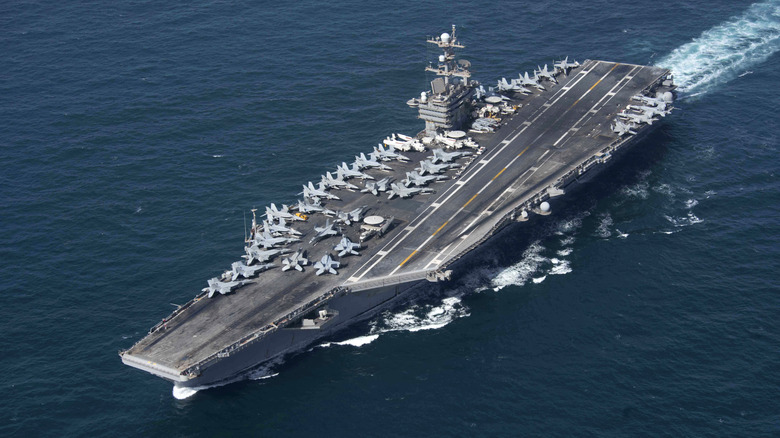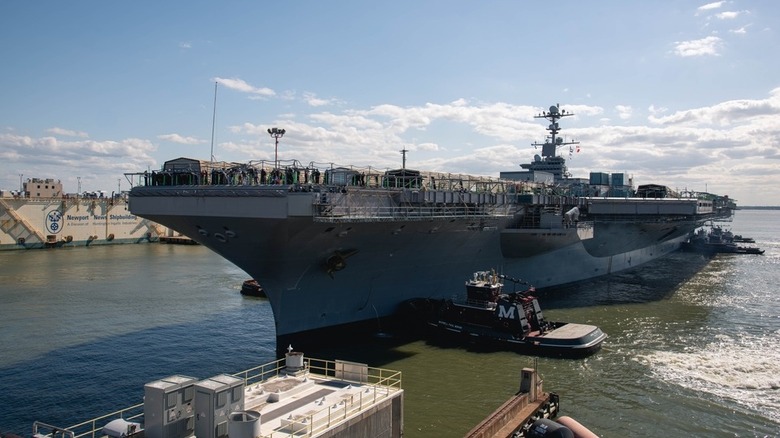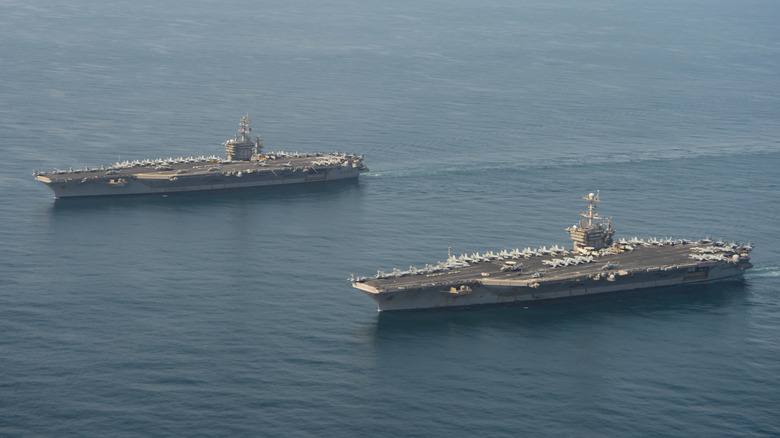America's USS John C. Stennis Aircraft Carrier Will Be Out Of Service For Years - Here's Why
Aircraft carriers are among the largest and most complicated pieces of military equipment to ever exist. These giant machines are so complex to manufacture that even the United States has only 11 of them. As the mainstay of the U.S. Navy for several decades, these ships have played a central role in projecting its military power far beyond its borders. Given how vital these ships are for the U.S., it may seem strange to learn that one of its aircraft carriers — the USS John C. Stennis (CVN 74) — has been out of service for several years now.
The USS John C. Stennis is a nuclear-powered Nimitz-class aircraft carrier. With no need to refuel, these ships practically have unlimited range and a design life of 50 years. However, all nuclear-powered aircraft carriers are expected to undergo a process known as Refueling and Complex Overhaul (RCOH) at the 25-year mark. This comprehensive overhaul involves thoroughly modernizing the ship and refueling it with enough nuclear fuel to keep it functional for the next 25 years of its life.
The USS John C. Stennis began its RCOH on May 6, 2021, and has been out of action since then. RCOH is a complicated process, and it is not uncommon for aircraft carriers to remain out of action for several years during the process. Current estimates suggest that the John C. Stennis will re-enter service by October 2026, which would mean that the vessel will have been out of action for over 5.5 years.
Why does an RCOH take years to complete?
It may sound improbable that it takes years for the U.S.' nuclear-powered Nimitz-class aircraft carriers to undergo an RCOH, but there's a perfectly understandable reason behind this. To begin with, an RCOH is the naval equivalent of open-heart surgery. Besides refueling the ship's nuclear reactors, the process also involves overhauling its propulsion systems, rewiring electrical networks, upgrading radar and combat suites, and literally tearing down and rebuilding sections of the hull. Every door, pipe, and turbine that's been running since the 1990s is inspected, repaired, or replaced. When finished, the carrier is essentially as good as new. The complexity of the task is why an RCOH takes years to complete.
Of the 10 Nimitz-class ships in existence today, six have undergone RCOH, and the majority of them took 4 years for the process to complete. The USS George Washington (CVN‑73), the last vessel to have undergone its RCOH (between 2017 and 2023), was out of action for nearly six years, with the RCOH costing $2.8 billion. It was also affected by pandemic-era slowdowns and supply shortages. Those delays eventually also played havoc with the RCOH timeline for the USS John C. Stennis as well.
All estimates now indicate that the vessel won't complete its RCOH until October 2026, and that is if things go to plan. In fact, there is already concern that the delay in bringing back the John C. Stennis to life will also affect the RCOH timeline for the next Nimitz-class aircraft carrier due for RCOH, the USS Harry S. Truman.
Why are the delays concerning?
The extended downtime of the USS John C. Stennis shows just how tricky and time-consuming it is to revamp a nuclear-powered aircraft carrier. What makes the process even more tricky is that the U.S. Navy relies on just one shipyard — Newport News Shipbuilding in Virginia — to handle these massive overhauls. So, when one project runs late, it slows down everything that follows. As explained earlier, the previous carrier to have undergone RCOH, the USS George Washington (CVN-73), was also delayed by pandemic-era disruptions, and that backlog directly affected the RCOH schedule of the USS John C. Stennis.
These delays matter because only a few of the U.S. Navy's 11 carriers are ready for full-scale operations at any time. When one ship stays under maintenance for over half a decade, the others must sail more frequently and for longer periods, which increases wear and fatigue for ship and crew alike. Then there are the financial implications. Each overhaul is an expensive proposition, costing anywhere between $2.5 billion and $3 billion, and any delay adds millions more in labor and material costs.
Still, skipping the process isn't an option. Without RCOHs, carriers would have to retire decades earlier than planned. When the John C. Stennis finally returns to the fleet around late 2026, it will carry new electronics, improved radar, and upgraded systems, ready to serve the U.S. Navy well into the 2040s.


